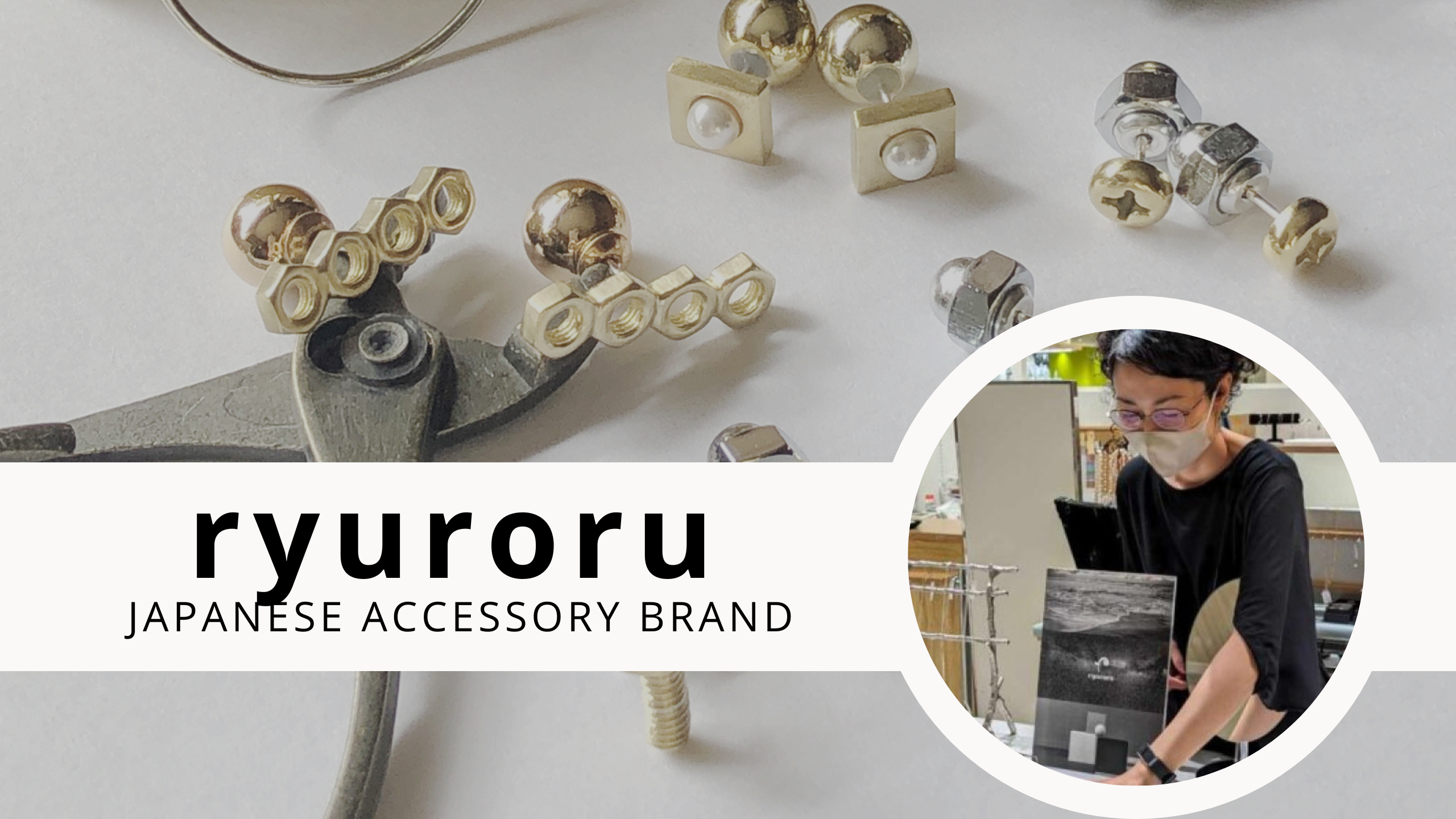
Japanese accessory brand “ryuroru” creates designs inspired by the ocean and the universe.


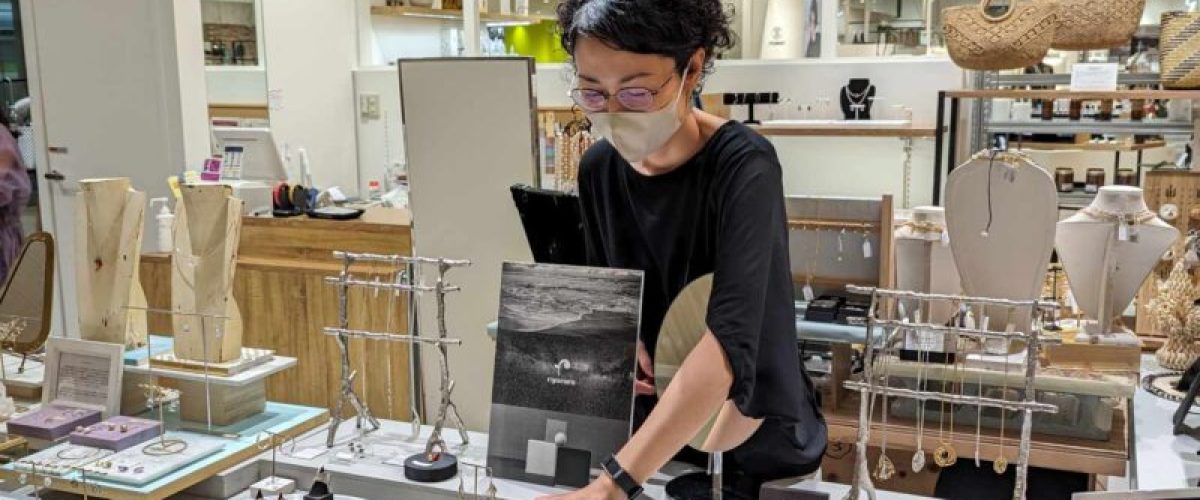
The concept of the brand is “the ocean and the universe”.
In launching the brand, I faced myself and asked myself, “What do I want to make and what do I want to cherish…? Looking back on my life, I realized that I had been drawing and creating things with the themes of “the ocean” and ” universe” since I was a child, and I drew from there.
The ocean and the universe” also appear as keywords. I am a Buddhist myself, and since my junior college was Buddhist-oriented, my experience of feeling that Buddhist art is the ultimate expression of beauty also lives on in my work.
Translated with DeepL.com (free version)

Based on the concept, I chose motifs from the three pillars of the ocean, the universe, and simplicity to develop the designs. Initially, many pieces were visually straightforward. For example, I directly incorporated waves and seashells into my accessories, creating pieces that conveyed the motifs clearly.
Over time, I gradually abstracted the motifs, allowing the viewer to imagine what the piece would look like in their hands.
In launching the brand, I had the invaluable guidance of two mentors.
One mentor taught me the business aspects of running a brand. The other mentor instructed me in the craft of making accessories. I attended a professional training course at an accessories school, where I learned the skills from the ground up.
After graduating from junior college, I worked as an office worker. From there, I kept changing jobs, always searching for what I wanted to do.
I worked as a designer’s assistant in the sales department of the restaurant industry and at an artists’ accessory store with its main store in Aoyama, Tokyo. I also worked as a designer’s assistant at an OEM accessory planning company. It took some time, but through these various experiences, I realized that what I truly wanted to do was both creating and designing.
After that, I started making accessories as a hobby. Then I faced a pivotal question: ‘Should I enjoy my hobby as a pastime or turn it into a career and pursue it seriously?’ I found myself at a crossroads.
At that time, I met a master at a class whose work deeply impressed me. I thought, ‘If only I could study under someone I respected…’ Looking back, it seems like a fortuitous fate. This encounter, which seemed coincidental at the time but turned out to be destiny, inspired me to move forward.
I expected it to take years to launch the brand, but the school was quite spartan (laughs). Within a year, I made my debut at an exhibition. It was the most driven and intense period of my life. Then, at the age of 31, I launched my brand.
I often sell my items at fashion buildings and art facilities such as PARCO and Spiral. I aim to be close to my customers so they can easily enjoy shopping with me.
We frequently exhibit at pop-ups and events rather than having permanent installations.

Around 2019, an acquaintance of mine exhibited at Arcade Japan, a pop-up store in New York City. Looking back, that experience was quite inspiring.
Later, I met a representative of RESOBOX, which promotes Japanese culture in New York, at an exhibition in Japan. This connection gave me the opportunity to meet and exhibit with Yoko, the representative of niji.
At first, there was only a small range of items to exhibit, so the response was weak. However, as the scale of the event grew, I began to focus on silver items, and the trend evolved into a viable business.
In terms of design, unique styles and lineups that are not as popular in Japan have been increasingly accepted by customers. I believe my expression and possibilities are expanding.
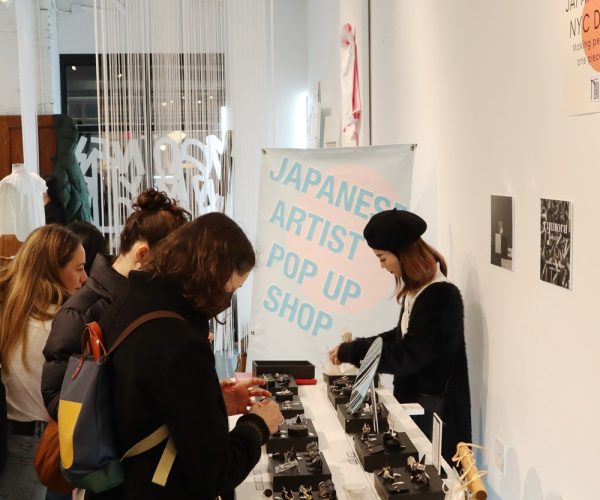

Niji is pleased to have you join us for an event at the Chelsea Market in New York City.
The power of the word ‘New York’ is especially eye-catching to young artists and designers. I would be happy if I could be an inspiration for them, encouraging them to try their hand overseas.
The experience gained by exhibiting abroad, rather than staying in Japan, should enrich their work.
One of the interesting aspects of the program is the difference in values that come from cultural differences, such as a design that doesn’t get much response in Japan but is well-received overseas. We would like them to experience this unique aspect of the program.
Our first goal is to receive orders from local store buyers.
To achieve this, we need to showcase our works in various venues and create opportunities for them to be seen by many people. We will carefully finish our works and secure funding. I believe that by building a track record, our dream will start to become a reality. I would be happy if I could make steady progress toward an evolving future, one step at a time.
We thank Ryuroru for her active participation in Niji’s events in New York. We are also very happy to help make her brand known to customers in New York. We look forward to continuing our collaboration and expanding our market in the U.S. through trial and error to fit the New York market.
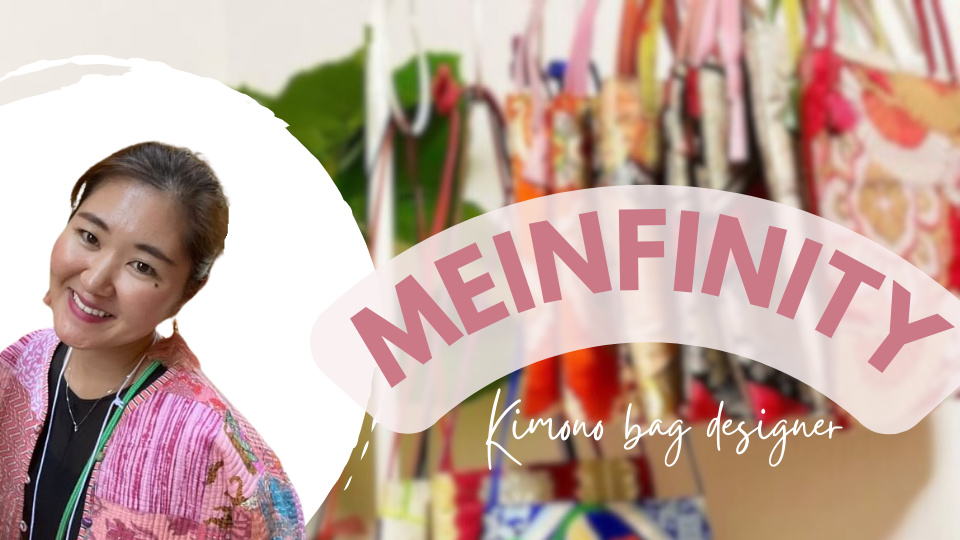
In recent years, even as a Japanese person, direct interaction with kimono in daily life has become quite rare. I was one of those who thought, “I’d like to wear it, but it takes time and money, and it’s high-end, so it seems inaccessible. My turning point came when I happened to walk into a recycled kimono store. At that moment, I picked up a kimono and examined it for the first time. Although I had no knowledge about kimonos, I was captivated by the item in my hands and thought, “The pattern of these flowers is incredibly cute! Being ignorant, I didn’t approach it from a traditional perspective, but saw it as a unique design that immediately caught my eye. As I stood in front of the mirror holding an obi I particularly liked, I intuitively felt, “This could be a clutch bag,” and this newfound discovery brought me joy. Without hesitation, I bought obis and haoris and started making bags at home.
I actually had zero skills. The desire to “give it a try” drove me to start from scratch by buying a home sewing machine. Both the sewing machine and kimonos were completely new to me, so I worked on my projects while visiting a kimono shop once a week. The women at the shop shared tips such as, “Since the fabric is thick, it’s better to use denim needles for the sewing machine,” and they provided various insights along with interesting anecdotes. By taking their advice, I was able to shape things little by little.
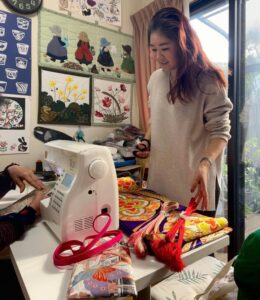
For the birthday of an American friend who lives in San Francisco, I decided to make a bag as a gift. It was the very first thing I posted on Instagram. At first, it was more of a record for myself, since I had just made it. Looking back, it was a simple creation without a pattern. But at the time, I thought it was quite well done, so I took it to the kimono shop I mentioned earlier. To my surprise, the elderly ladies who were customers there said things like, “Anyone who buys this must be pitiful,” and expressed various negative opinions. I was really upset and thought, “I’m going to prove them wrong
Yes, I used to make them as a hobby. Later, I happened to participate in a garage sale and sold my creations for the first time. Art students from an art college happened to be there and were happy to buy them. It brought me great joy to see something I had made being sold and recognized.
After that, as I gradually created more and shared them on Instagram, I received positive reactions from foreigners. Thinking, “Maybe this could work,” I sent them to friends in France, New York, Canada, Thailand, and Korea and asked for their opinions. The responses were very different from those of Japanese people. While the Japanese tended to see the pieces as “kimono patterns,” the foreigners saw them purely as “designs. They appreciated the work without preconceived notions.
In addition, people of mixed Japanese ancestry expressed their happiness by saying that wearing my bags became “part of their identity” and “having something Japanese made them proud. Hearing this, I was convinced that my creations had value beyond just being bags.
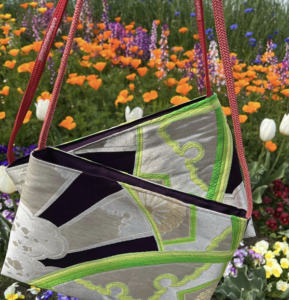
Yes, from this experience, I started a brand to turn it into a business.
So I went to New York, where I had researched and found many foreigners selling kimonos.
I walked around New York every day with my most colorful homemade bag. I approached people who seemed to like Japan, sent DMs to various people, and even attended Japan festivals where Japan enthusiasts gathered.

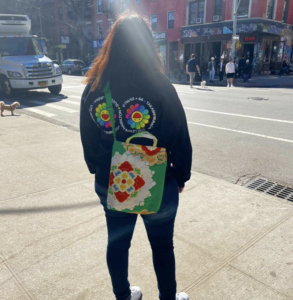
In Japan, although it may be different for the younger generation, there are generally strict rules regarding kimonos. The patterns vary with the seasons, and there are many times when they cannot be worn. Because of the deep-rooted traditions, many people don’t see them as “fashion.
However, I want to promote these patterns as “designs” and “fashion. That’s why I had to go to America. In New York, I was able to prove that they are accepted with a completely different sensibility than in Japan.
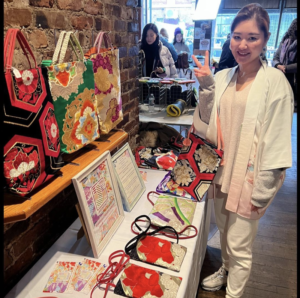
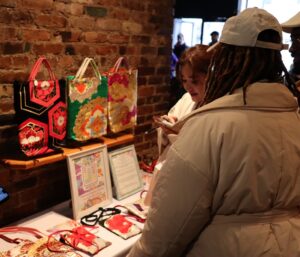
Wearing a kimono is like wearing a “Japanese painting”. If you cut out part of the pattern, it is truly art in itself. I am fascinated by kimonos in this way, and to make them more accessible as a fashion, I arrange them in a contemporary style and share them.
Many Japanese people often say, ‘I don’t know how to coordinate it. When I talk to people, many of them express interest in kimonos and want to own one, but the fear of being judged by others acts as a significant barrier; it basically boils down to the idea that it’s difficult to use because others don’t use it. However, foreigners tend to act on what they personally want rather than how others perceive them. It’s as simple as “I think it’s cute, so I’m going to use it.

When I share on social media, a significant number of interested people are foreigners, especially those from Western countries. For the past two years, as I have been shuttling between New York and Japan, I have been acutely aware of the differences in response.
I want to shine where there is demand. In Japan, I received a lot of negative comments. However, considering the drastic change when I moved to New York, I think the first focus should be on expanding internationally.
To make my debut overseas at the age of 8, my parents applied for a program organized by Shizuoka Prefecture. We sailed to Saipan and Guam during spring break. Then, in my first year of junior high school, I participated in a student exchange program to Nepal with our sister school. In my second year, I went on an educational trip to Hawaii. Through these experiences, I became aware of the differences between Japan and other countries at a young age.
As a result, I had many questions about unique Japanese rules, such as “Why can’t you dye your hair? “Why are piercings not allowed?” and “Is the discipline of seniors and juniors really necessary?”
Later, as a college student and professional, I continued to travel between Japan and overseas, making use of my experiences abroad. Whenever I go abroad, I always feel a sense of excitement. The more I do, the more acquaintances I make and the more connections I establish. When I am invited by locals, my response is an immediate “Yes!”-I act immediately.
When you make decisions and take actions on your own, people around you naturally support you. The ability to act is made possible by the support of cooperative people. From the outside, it may look like I’m doing everything on my own, but it’s really the support of those who agree with me that makes my actions possible.
I also have a rebellious spirit. In response to people who bring negative opinions, I want to show results and prove them wrong.
I would like to delve deeper into the world of kimono and materials (fabrics, etc.). While refining my sewing skills with the help of my skilled aunt who is a dressmaker, I am eager to learn more.
In addition, I strive to emphasize the sense of uniqueness, such as the use of high-quality fabrics and threads, and the creation of precious items through special weaving techniques. In addition to focusing on design for international audiences, I plan to incorporate the cherished traditional culture of the Japanese and ensure that each pattern carries a meaningful story.
By showcasing aspects that may go unnoticed if confined to Japan, I hope to prove that they can shine when presented to a global audience. It would bring me great happiness to envision a future where the wonderful traditions and cultures I bring abroad contribute to a significant and widespread impact.

If you are interested in purchasing Japanese handmade products, please have a look at our marketplace!

Textiles are fabrics made by crossing warp and weft yarns.
Japanese textiles are a very profound craft, handmade one by one by craftsmen using traditional methods handed down from generation to generation.
Japanese textiles have a long history.
Since its birth in ancient times, its manufacturing methods have been handed down from generation to generation and have repeatedly developed in unique ways in various regions.
The origin of Japanese textiles is not clearly known but weaving tools have been found at ruins from the late Jomon to Yayoi periods. However, it is believed that textiles already existed before that time.
At this time, textiles were mainly made from plants such as hemp, fabrics made of silk would have been exceptionally rare.
In the Nara period (710-794), more advanced weaving techniques were introduced from China, and high-quality silk fabrics began to be produced. However, these were worn only by a few upper-class people, and the common people mainly wore hemp fabrics.
Silk fabrics continued to evolve with the times, and by the Edo period (1603-1867), silk fabrics were being developed in various regions of Japan.
Since silk fabrics were produced all over the country, even warriors and wealthy merchants other than the upper class came to wear silk fabrics.
However, in order to prevent the value of silk from falling, the common people were forbidden to wear it, and they ended up wearing hemp or cotton garments.
Textile production methods spread throughout Japan, and manufacturing processes changed to suit the climate and culture of each region. Here, we first explain the manufacturing methods used for textiles in Japan.
Tsumugi is a fabric made of silk or cotton.
It became popular in the Edo period (1603-1867) and gradually came to be treated as a luxury item. It is characterized by its strong durability.
100% silk. This textile is made mainly on Amami Oshima Island in Kagoshima Prefecture and is one of the world’s three major textiles. It is said to take six months to a year to make one piece, and it is said to be durable for 150 to 200 years even when worn as daily wear.
Kasuri is a textile made from yarn dyed in two or more different colors. There are a number of techniques related to textile patterns, but kasuri is characterized by the partial dye-proofing treatment applied to the threads before weaving to create a unique blurred appearance.
Lorem ipsum dolor sit amet, consectetur adipiscing elit. Ut elit tellus, luctus nec ullamcorper mattis, pulvinar dapibus leo.
One of the three major kasuri fabrics in Japan. This textile has a long history dating back to the Edo period. The works produced by skilled craftsmen have many fans and are now used for items familiar to us in our daily lives other than kimonos.
Nishiki is a general term for silk fabrics woven with two or more colors of threads. It has been hand-woven using looms that were introduced to Japan from China at least 1,200 years ago. It has been considered luxurious since ancient times and is characterized by gorgeous patterns.
Nishijin-ori is the general term for a traditional weaving technique practiced mainly in Kyoto (especially in the Nishijin area).
It uses multi-colored threads to create beautiful patterns.
There are 38 types of textiles designated as “traditional crafts” by the Minister of Economy, Trade and Industry.
All of them are well-known textiles, and all of them are made by methods that make the most of their regional characteristics and are comparable to each other. The following is an excerpt of some of them.
and 30 other types (in no particular order)
It could be said that the kimono culture has encouraged the development of textile culture.
Kimonos and obis are the culmination of all textile techniques, and there are kimono museums in Tokyo, Fukushima Prefecture, and Kyoto Prefecture.
In addition to kimonos, you can make all kinds of daily necessities out of cloth.
As mentioned above, the kimono is the most representative textile-based item.
During the Edo period, almost all Japanese citizens wore kimonos.
Unfortunately, however, it is rare to see people wearing kimonos in general in modern Japan.
In modern Japan, if you walk down the street wearing a kimono, people will think it is a hobby, an event, or that you are a rich person, etc. It is unlikely that you will be thought to be wearing it on a daily basis as everyday wear.
There is no definitive record of when the kimono culture died out and when ordinary Japanese began to wear western-style clothing, but it seems to have gradually disappeared from their living environment about 100 years ago due to the flow of western culture and the convenience of western clothing.
For women who are now in their 70s or older, it was a kind of custom when they were young to wear a well-tailored kimono as their wedding garment.
So, after grandmothers pass away, many kimonos are often found in the paulownia-wood chests that were used to store kimonos.
Unfortunately, grandchildren would never have a chance to wear them, so there is often little choice but to dispose of them or sell them to a vendor.
However, expensive kimonos and kimonos that we have a special attachment to are the ones we would like to keep.
The trouble with kimonos is that they take up a lot of space and are difficult to preserve.
In particular, expensive kimonos are made of silk, and silk kimonos are easily eaten by insects and quickly damaged. For this reason, one popular craft idea is to remake just a portion of the kimono and turn it into a purse, hair ornament, etc.
There is an attempt to remake kimono that are no longer worn or have holes in them and bring them to the world as new products.
Kimono patterns have traditional and uniquely Japanese stylistic beauty and are of interest to people overseas as well.
and many other items
Kimono-patterned accessories are often displayed at handmade markets around Japan. If you are interested, please stop by.
Each hand-woven textile is the culmination of a craftsman’s skills, and just by looking at such textiles, you can feel as if you have been touched by a powerful art form.
Weaving requires skills and specialized tools, and it is difficult for an amateur to start weaving from scratch in a workshop.
However, kimono remakes are easy to start even for beginners.
I dream that Japanese textiles will be seen by many people around the world
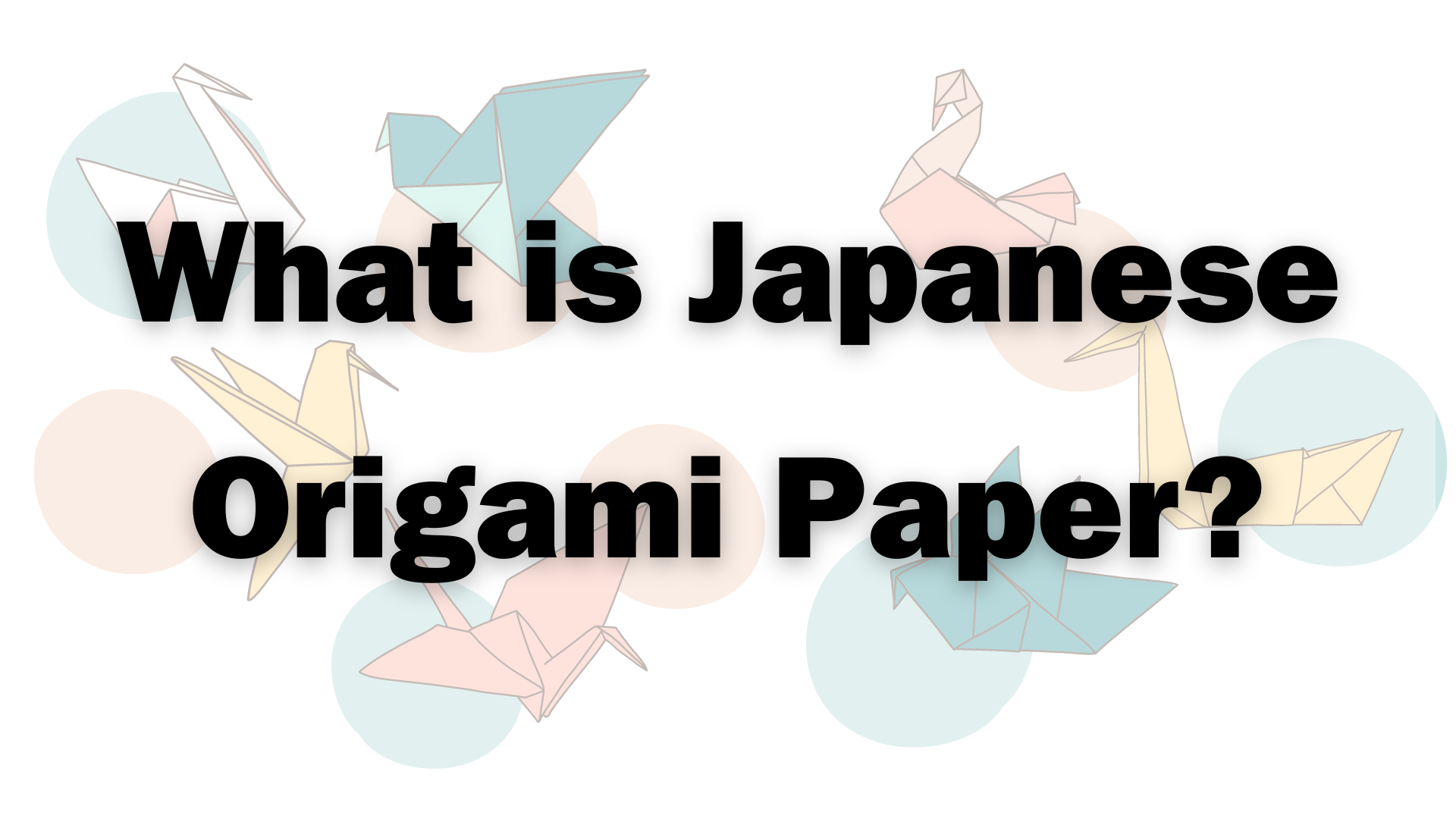
Origami is one of the traditional handicrafts that are widely popular among the general public.
Origami is a handicraft that requires no tools, skills, or space, and can be played with whenever the mood strikes.
In this article, we will explain the history of origami and how it is actually folded.
For Japanese people, origami is something they are very familiar with, used for play at home and in preschools or kindergartens.
First, I’ll summarize the basics of origami, from its history to the different types of folding techniques.
In the early 7th century, paper manufacturing methods were introduced to Japan from mainland China, and Japanese people’s ingenuity gave birth to washi, a thin and durable paper.
Washi was an important item for sutra copying and record keeping, but eventually “ceremonial origami” was created to accompany gifts and other items, and “playful origami” was created for the purpose of playing.
Origami can be made on basically any paper.
The most used shape is the square, but there are also origami papers folded in other shapes such as rectangles and triangles.
The most famous origami pattern is chiyogami.
Chiyogami is paper printed with traditional Japanese patterns such as hemp leaves and deer.
Some people may associate chiyogami with origami cranes, as it is the paper often used to fold origami cranes.
Origami has several fixed ways of folding.
It’s read, “Fusetsu (No cutting) Seihokei (Square) Ichimai (one piece of paper) ori (fold).
This is a folding method using only one square sheet of paper, without using scissors.
This is the basic type of origami, and some people prefer it.
A folding method that first folds several parts separately and finally combines them into a single piece. A traditional example is the combination of “yakko-san” and “hakama”.
By joining separately folded parts together, it is relatively easy to create complex shapes without cutting into the paper.
In some cases, glue or staples are used to join the parts together.
This is a folding method that makes it easier to fold complicated shapes by making cuts in the paper to increase the number of corners or by cutting out a portion of the paper. Some origami enthusiasts have negative opinions about this method because it is not a straightforward method, such as using scissors.
A toy that can be moved. There are old examples such as “camera” (the shutter opens) and “flapping bird” (you can move its wings by holding its neck and tail).
These are popular for playing with children because they attract their interest.
There are many advantages to playing with origami.
Here are just a few examples
Can be done anywhere
Easy to take with you when you go out
Costs very little
The only cost is for paper
Can be played by both men and women
Physical differences are not a handicap
No need for scissors, staples, or glue
No need to use extra items
Encourages conversation with parents, children and grandchildren
Helps develop imagination
There are countless variations of how to fold
You can discover new things to fold, depending on your ideas
Crane is the most famous origami among all the origami.
This is because Japan has a tradition called “Senbazuru,” which means “a thousand cranes made of origami. This is said to have become Senbazuru as a lucky number from the phrase “a crane is a thousand years.” It is said that classmates, friends, and acquaintances fold origami cranes and give them to patients who are hospitalized for illness, etc., as a message to pray for their health recovery.
Armor worn on the head in battle. In Japan, helmets first appeared in the Kofun period.
The helmets worn by those in command in particular were unique to each army, and some of their designs are still talked about today.
The original function of the helmet was to protect the head, of course, but warlords attached unique tatemono (ornaments) to their helmets in order to stand out on the battlefield and show their dignity and status by wearing a glittering helmet.
When I was a child, I used to fold letters between friends in this slightly unusual way.
When I folded them this way, my parents couldn’t see them…. My parents could not read it secretly because they could not re-fold it (since they did not know how to fold it).
There are many simple and cute shapes like this. The “balloon” is a simple and cute shape that can be folded in a very simple way.
This is a type of origami that can be folded and played with, rather than folded and displayed.
Like a balloon, it can be blown up by blowing into it, so you can play with it by bouncing it with your hand or throwing it.
Children may be pleased if you use a large piece of paper to make it.
This is one of the trick folds as well. When you hold down the bottom part, it bounces like a frog. It is made of paper, so it is safe for babies to hold.
You can make several and have a race with your friends.
Shuriken origami is also popular.
You can actually throw them or combine different colors to make colorful shurikens.
The shapes are also interesting and can be used for art and other purposes.
There are many more origami videos on YouTube.
The ideas are varied.
Please enjoy crafts using your favorite patterns and papers.
Origami is an excellent handicraft that is low in cost and can be played with by children and adults alike.
We hope that this article will help spread the joy of origami to more families with children who are just learning to play with their hands, as well as to relatives’ gatherings and classrooms.
We have a wonderful seller who creates beautiful origami earrings.
Please check out our online store below.
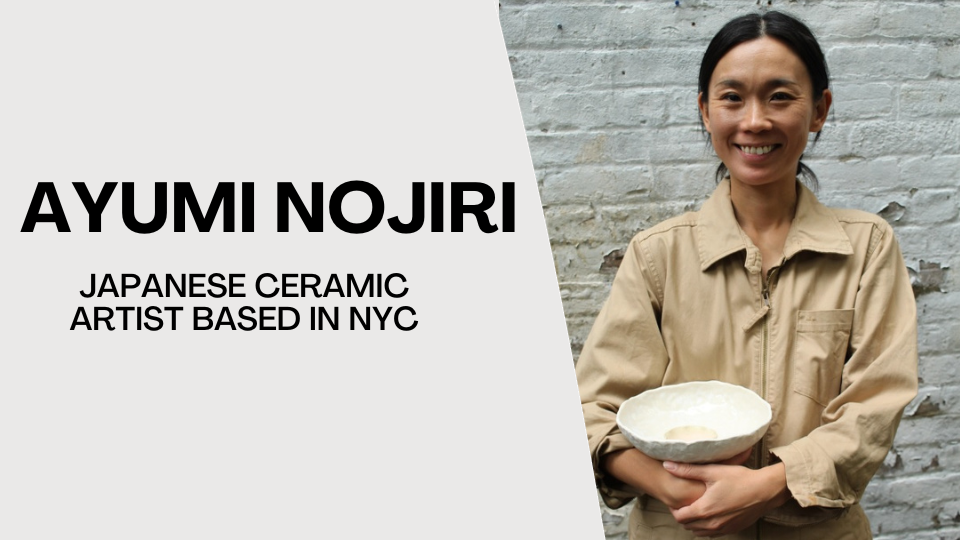
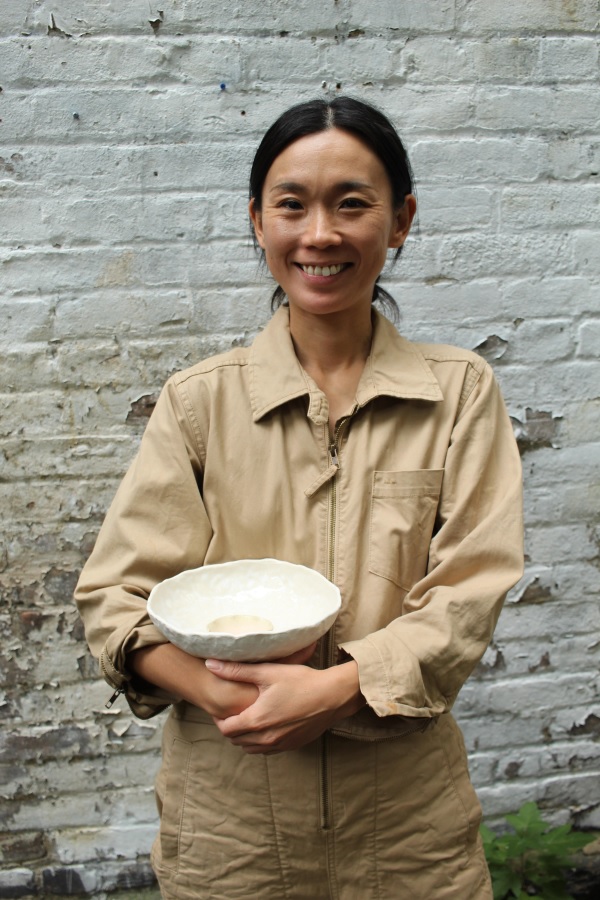
I make ceramic tableware and flower vases. I like white-color ceramics, so most of my works are coated with a white glaze. More recently, I have created more pieces with pale green patterns on a white background as well as black pieces. Because ceramics can be easily customized by selecting combinations of various clays and glazes, we can generate handmade ceramics based on our inspiration. I also create pieces in a variety of colors and shapes according to my customers’ requests.
My works are mainly sold at flower shops and artwork stores in and around New York City. I also receive custom orders for tableware from restaurants. My designs have been well received by my customers as they go well with food and flowers. My works are also sold on a consignment basis through ceramics shops and events. The mugs are especially popular these days.
I’m originally from Osaka, Japan, and grew up watching my parents who had worked in the fashion industry. I loved sewing, crafting, and cooking even in my childhood. Retrospectively, I think my parents with creative jobs had significant influences on my artistic interests. No matter what, I really loved crafting handmade items.
After graduating from a university in Japan, I worked at an advertising firm for about a year. However, my health gradually deteriorated in trying to manage the intense workload; I eventually had to quit the job. While thinking about my future career and life, I was inspired by my mother, who worked globally as a fashion designer. Eventually, I decided to move to the United States. I did not have a detailed plan on what to do after coming to the United States, but I wanted to see overseas and test my abilities. I chose New York as my destination, as it is a city with many artists. I was 24 years old at the time.
One day, a while after I came to New York, an idea to make some ceramics suddenly emerged. I decided to attend the local ceramics classes in New York run by a Japanese owner. There was no particular reason or plan for this either; it just came to me one day. It was a pretty similar situation in which people think, “Maybe I should start going to the gym.” In those classes, I learned about ceramics from scratch. I had no knowledge and experience of ceramics whatsoever until then.
A few years after I started joining the classes, the owner asked me if I was interested in becoming an instructor for the same classes. I accepted the offer and started teaching. I had been teaching for about three or four years, but due to the pandemic, the class operations were temporarily suspended. On top, my two daughters were young back then. Those conditions made me put my teaching job on hold. However, I continued my crafting activities while my children were asleep or when they were at school.
Meanwhile, through my friends and personal network, I started to get several offers to sell my ceramic pieces to flower shops and restaurants or on consignment. There was a time when I was proactively marketing my products myself, but thanks to everyone’s support, I was able to rapidly develop a sales network.

The great thing about ceramics is that everyone from children to adults can enjoy making pieces. Ceramics are enjoyed all over the world, regardless of country or culture. It is very attractive that we can freely create ceramics with our own hands from soft clay and we can use our works in our daily lives. While teaching the ceramic classes, I loved seeing students of various ages and levels have a lot of fun making their handmade pieces.
Since I have two young daughters, it can be difficult to work as an artist while raising children. But recently, my daughters have expressed interest in making ceramics. We sometimes make some pieces together. Every time I see my daughters passionately working on their creations, I feel like I have returned to my early years as an artist and experienced the joy of ceramics all over again.
There are many steps involved in making ceramics, and it takes time and effort to complete a single piece. Just because you put in a lot of time and effort doesn’t mean you’ll end up with a wonderful piece. Many works just do not meet my initial expectations. However, if it is before firing, pieces are recyclable so we can recreate something new from scratch. Ceramics is an art field with a lot of freedom. I am noticing that more and more young generations in the United States are becoming interested in ceramics.

I met the organizer of the Japanese Artist Pop-up Shop at one event; that’s how I was invited to the pop-up shop. Although I have participated in many events, I got the impression that the Japanese Artist Pop-up Shop was exceptionally well taken care of by the organizer. Since every detail was carefully planned, I was able to participate smoothly with peace of mind as an artist. I recommend other artists consider joining the event too.
I also liked the fact that the event was held in the East Village, Manhattan. My works are not particularly inspired by Japanese culture, but the area has many Japanese restaurants and is always busy with local New Yorkers who are interested in Japanese culture. During the event, I received many questions from customers regarding my work. Some American customers had knowledge of traditional Japanese porcelain, such as Arita ware, and I was able to feel firsthand that Japanese culture is widely loved in the United States.
I have a plan to teach ceramics classes at an art studio, which is scheduled to open in 2024. While I like making pieces myself, I also want people to know the joy of making ceramics. Thus, I am really looking forward to teaching the classes. Also, because the owner of the new studio has a Korean heritage, it would be great if we could mix the best parts of Korean and Japanese ceramics to create new, unique pieces.
Additionally, I plan to arrange more collaborations with tattoo artists. My husband also owns an art brand and designs and sells products by working together with various artists. Through the process, I have developed friendships with tattoo artists. Those artists once added tattoo-themed illustrations to my ceramic pieces and we sold them as a joint work. I would like to organize more of those collaborative projects in the future. Through their tattoo illustrations, we may be able to craft works with more Japanese tastes.
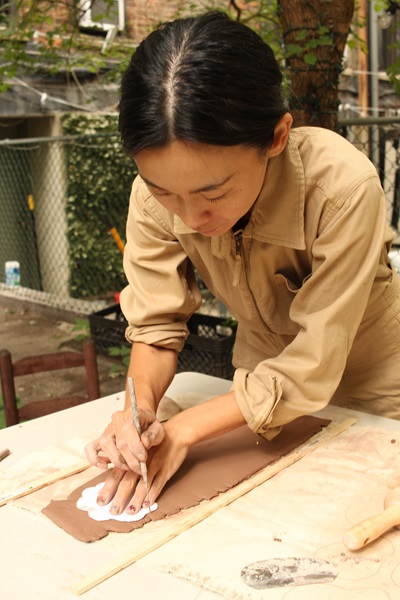
If you’re interested in learning more about Ayumi Nojiri’s work, please check out her Instagram.
Check out the following website for the future schedule of the Handmade Makers Market organized by niji: Website. You can also purchase handmade pieces crafted by Japanese artists online: Online Store
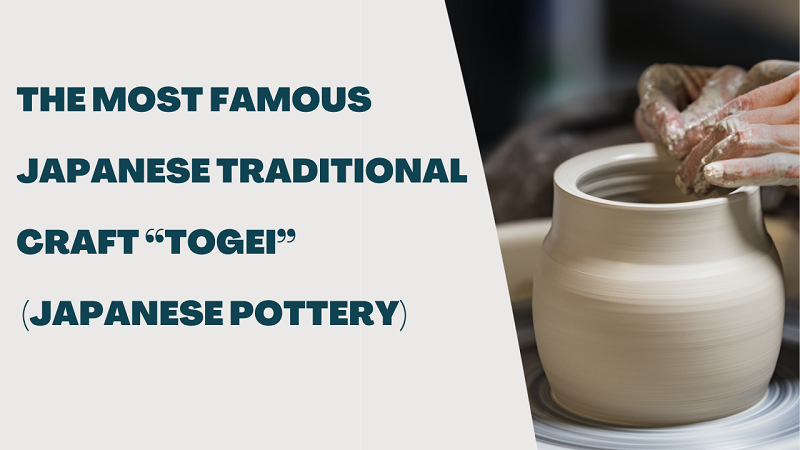
In Japan, there are many crafts called “Dento Kogei (traditional crafts)”, which are made using skills and techniques that have been passed down over the years.
Many traditional crafts are made from materials produced in the region and cannot be made anywhere else.
This article focuses on one of the most popular traditional pottery, Togei.
Togei is the art of molding clay and firing it at high temperatures to make porcelain and other forms of pottery.
Generally, Ceramics indicate both “Pottery” and “Porcelain” both are also called Yakimono, which is equivalent to the English word “Ceramics”.
The table below shows the characteristics of each.
Pottery
Famous Pottery|Mashiko-yaki, Hagi-yaki, etc. Care|After purchase, soak in water or lukewarm water for about half a day. Water absorption prevents oil and odors from soaking in when cooking. When drying, do not allow the vessels to overlap each other, and store them only after they are completely dry. |
Porcelain
*If painted with gold or silver decorations as decoration, No.
Famous porcelain ware|Hasami-yaki, Kutani-yaki, Arita-yaki
How to care for porcelain|It does not need to be watered first like ceramics.
Porcelain is more durable than ceramics, but it is thin and prone to chipping and cracking.

The “Nihon Rokkoyo (The Six Ancient Kilns of Japan)” is the collective name for six kilns that have continued to produce pottery to the present day, while inheriting pottery techniques that have continued since the Jomon period.
The six kilns are Echizen, Seto, Tokoname, Shigaraki, Tamba and Bizen.
These were recognized as “Japanese Heritage” in 2017.
It is said that Japanese ceramic techniques mostly derive from China and Korea.
However, only the Six Ancient Kilns of Japan are distinguished as genuine Japanese pottery.
Echizen pottery has a rustic texture and is made of red clay, which is locally available and can withstand high temperatures due to its high iron content.
https://www.town-echizen.jp/en/
Seto-yaki is pottery with colorful paintings and lines added using a variety of glazes.
It was the only pottery made with glaze in the medieval period.
https://www.setoyakishinkokyokai.jp/
Uses iron-rich pottery clay from the Chita Peninsula.
http://www.tokonameyaki.or.jp/
Shigarayaki is made of coarse clay and is highly fire-resistant.
Large ceramics are often made.
https://www.593touki.jp/shigarakiyaki.html
This color uses “natural glaze” without artificial glaze.
This pottery is popular not only for practical use but also for ornamental purposes.
https://kogeijapan.com/locale/en_US/tambatachikuiyaki/
Bizen Pottery is fired for a long time without painting or glaze.
This is the ultimate simple pottery made to enjoy the texture of the clay.
The dish tray in which food is placed is called a “Utsuwa”.
In Japanese households, each side dish is usually served on a different dish and eaten separately.
Therefore, the amount of dishes needed is also the amount of containers needed.
It has long been said that a well-balanced meal should consist of “one soup and three types of vegetable,” and many households still follow this basic rule.
Ichiju sanzai” refers to a menu consisting of one soup and three side dishes.
Ichiju: Ichi means one, jyu means soup. As the name implies, it is a soupy dish, such as miso soup.
San-sai: San means three, Sai means dish/meal. It consists of one “main dish” and two “side dishes” (three side dishes in total).
This “Ichi jyu San sai set” is served with rice (staple food).
Basically, each side dish is served on a separate plate.
For example, sautéed spinach is placed in a dish with yellow lines to enhance the green color, grilled fish is placed on yakimono to express the beauty of nature, and if the season is early spring, the drinking cups are made of pottery with cherry blossoms painted on them, provoking thoughts of the cherry blossoms that will bloom soon.
Nowadays, porcelain with simple shapes, which is easy to take care of and hard to break, is preferred for ordinary dining tables.
However, even today, meals are served in a variety of dishes at ryotei or Ryokan (traditional Japanese restaurant or hotel).
Enjoying these dishes is one of the best parts of traveling.

Here are some basic pottery techniques.
If you are interested in pottery, we encourage you to actively participate in pottery workshops.
What you can make with pottery:
Vases, dishes, cups, chopstick rests, wind chimes, aroma lamps, musical instruments, dolls, Christmas ornaments, etc.
<Terms frequently used in Pottery>
Tebineri (hand forming)
A technique in which clay is shaped by stretching it with the fingertips. There are basically no restrictions on the shapes of ceramics that can be made using the hands alone.
It is possible to make not only everyday vessels such as tableware and cups, but also ornamental items such as large pots and chopstick rests.
Rokuro (Potter’s Wheel)
The motorized or mechanical potter’s wheel is operated by stepping on a pedal at the foot of the potter’s wheel to rotate the stand.
By using centrifugal force, it is possible to make beautiful vessels of well-defined shapes.
However, because the speed of rotation is very fast, it takes some practice to become proficient.
Also, since there is a limit to the shapes that can be formed, the rokuro is not suitable for certain items that you may want to make.
Typical shapes include vases, tableware, and jars.
Etsuke (Painting)
In the process of painting, colors are applied directly to the pottery, which is then covered with a transparent glaze before firing.
Famous pottery with painted decoration|Kutani ware, Imari ware, and Arita ware.
Yuyaku/ Uwagusuri (Glaze)
A glassy coating material when glaze is applied to the surface of unglazed ceramics and fired again.
Glazes give color, luster, etc., as well as increase the strength of the pottery and protect it from water and dirt by decreasing its water absorbency.
The variety of glazes is unlimited, depending on raw materials and formulations.
Hori/ Kizami (Carving)
The surface of a vessel is decorated with an uneven surface using a stick or blade.
This technique has been used since Jomon pottery, and there are a variety of techniques.
Nerikomi (Kneading)
Two or more types of clay of different colors and the same hardness are kneaded together before forming.
Comics are also popular in Japan.
Japanese comics are drawn in a variety of genres, and of course, there are comics about ceramics.
Even if you are not interested in comics, you may be interested in a comic about ceramics in Japan.
The most famous ceramic comic.
The theme is Hagi Yaki.
Complete in 15 volumes.
Sequel to Hi ga Hashiru above.
Complete in 9 volumes.
The story is about the main character, Haruka, who is so impressed by a piece of pottery that she quits her job and goes to apprentice herself to the artist.
The theme is Bizen Yaki.
A story of Utsuwa and love, set in Hasami, Nagasaki.
The theme is Hasami Yaki, famous for painted Utsuwa.
A manga about ceramic art featuring a man. The main character is a gentle potter, but in fact, his secret identity is that he is an “underhanded potter” who solves all kinds of troubles related to ceramics for rewards of tens of millions of yen.
It is a story about a girl from England who is fascinated with being a potter and trains herself in the art.
The theme is Shigaraki ware.
Although not a pottery manga, it is a long-selling comic that colorfully depicts Japanese cuisine, vessels, and other aspects of Japanese culture.
One of the main characters, “Yuuzan Umehara,” is a potter.
In this article, we introduced one of Japan’s traditional crafts, ceramics.
Ceramics is still one of the most popular crafts today, with workshops being held all over Japan.
If you have a chance to attend a pottery workshop, please do so.
We will continue to send out information about various Japanese crafts in the future, so please look forward to it!
Interested in exploring a diverse range of Japanese handmade items?
Our platform “niji ” has selection of products crafted by talented Japanese artists. Discover unique creations from here!
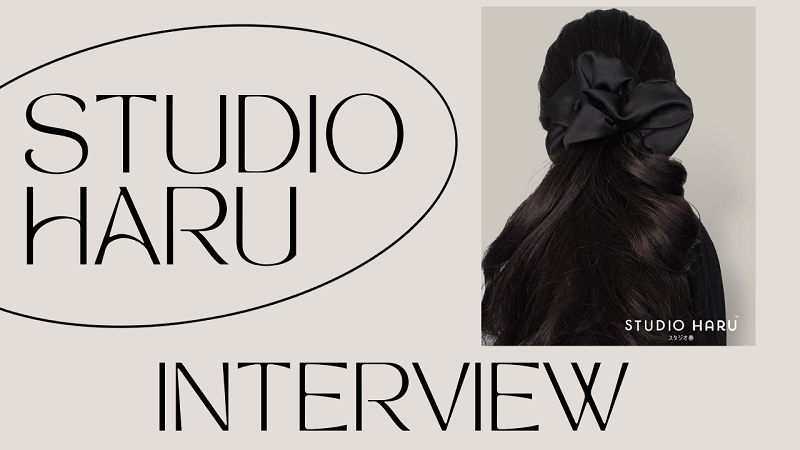
We interviewed ‘Studio Haru,’ who is based in NY artist and she explained her brand and herself to us. She also talked about her experience at our pop-up event on July 9, 2023.You can check the details about the event she attended here!
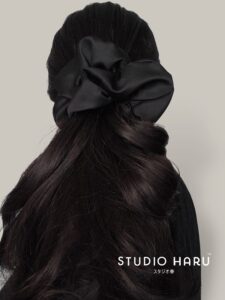
I don’t like showing my face in pictures generally because I am an extremely introverted and shy person, and thinking about it even more, it’s also because I don’t necessarily want to be recognized by the way I look/appear but instead I want to be recognized by my work. I am not looking for fame, that isn’t my cup of tea. All I want to achieve is to put a smile on people’s faces with our products.
Studio Haru’s website
I have worked in the fashion industry for a long time, and the experience made me feel that there can be constraints in the industry that limit an artist’s creativity. I love to freely craft new designs and products based on the inspirations in my head through the “try-and-see” process. But, there is an atmosphere in the industry where rough ideas and the process are not welcomed. I wanted to launch my own brand and give shape to my inspiration without any limitations.
The brand name Studio Haru comes from both my ability to speak Japanese and my favorite season, spring (“haru” in Japanese). However, the brand does not necessarily reflect the image of spring. For instance, Studio Haru’s brand colors are dark blue and earthy orange, instead of bright colors such as pink and yellow which are usually associated with spring. This is also because we value inspiration. We sell various items crafted through our own inspirations, not based on existing frameworks.
Studio Ghibli movies and Japanese food have helped foster my interest in Japanese culture since childhood. I have both Latin American and Chinese heritage and speak five languages: English, Japanese, Chinese, Korean, and Spanish. I often attempt to include the essence of some or all of these five cultures in my work because I love all of them! Japanese culture, in particular, symbolizes the warmth of the Japanese community. I believe Japanese culture welcomes and accepts other cultures’ collaboration. As an artist with no background in Japan, I sometimes get worried that my works might “invade” Japanese culture. However, every time I participate in an event celebrating Japanese culture, I can feel that my products are warmly welcomed and my fear is groundless.
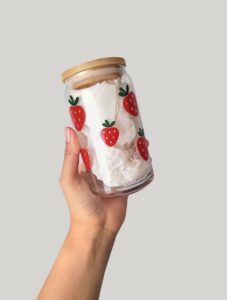
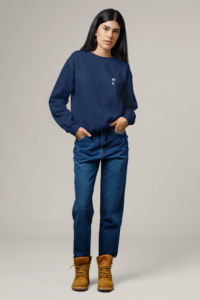
My grandmother and mother have had significant influences on my career as an artist. During my childhood, I used to watch my seamstress grandmother sewing and my mother making handmade clothes for my siblings and me. These experiences made me interested in creative work. My father, who is an entrepreneur, also inspired me to explore the idea of launching my own brand. Since I was a child, I have enjoyed crafting various handmade products, but making fabric products and outfits is particularly special; it allows me to feel connected to my grandmother and appreciate her. Thus, those products have a special presence in Studio Haru.
Furthermore, after I started working in the fashion industry, I was able to combine my creative and fashion sides together. The reason why Studio Haru sells both creative items and fashionable clothing is because of this personal growth. Today, I am inspired by various things such as children playing in a local park in New York, dreams that I have at night, movies, music, food, etc. I write down my rough ideas in my journal every day and gradually turn them into designs and products.

I founded Studio Haru in 2019, but then the pandemic hit us. As a result, we were only able to sell items online for a long time. Last year, we were finally able to set up a physical booth at events and markets. Since then, we have proactively looked for events where we could participate as a seller, but at the same time, we have carefully chosen events based on the location and the participants’ demographics.
Studio Haru’s core customers are young people in their 20s and 30s, who are interested in Japanese and Asian cultures, as well as students who regularly use stationery. There are also many customers who prefer simple outfits. Thus, an ideal event for Studio Haru would be an indoor venue in the New York area, where there are many young people and heavy pedestrian traffic on weekends. Given these points, the Japanese Artist Pop-up Shop was an ideal event for us.
In fact, participating in the event was a huge success. Many people living in New York stopped by our booth and looked at our products. I was also able to receive new inspiration from the works of other artists. In addition to the location and the participants’ demographics at an event, I believe close distance with customers is also a success factor. At the Japanese Artist Pop-up Shop, the indoor setting allowed me to talk to many customers. This also makes me believe that joining the event was a success for us.
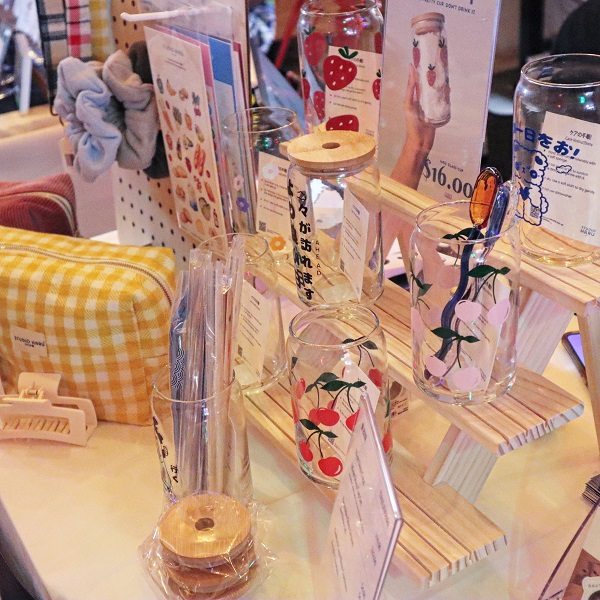
I am grateful to my husband, family, friends, and others who value my inspiration and support our brand. Currently, my husband and I manage Studio Haru. Due to the large number of items we sell, it can be very challenging for the two of us to oversee all of the production processes, event participation, and online transactions. However, my husband always supports me with the belief that “If you have an idea, you should try it!”
Also, my father shares a lot of business know-how with me. His advice backed the successful launch of Studio Haru. During the pandemic, we also asked for help from our friends and their friends to quickly set up our website and start selling items online. We often take photos of the items ourselves to post on the website, but if we need professional support, we ask our friends to introduce us to potential candidates.
With the support of various people, Studio Haru has been able to boost its popularity and trust as a brand. I am very grateful to those who have supported us. It is because of all of you that we have been able to come this far through our try-and-see process.
Our short-term goal is to open a physical store. As for its location, we would like it to be in a lively place, like the East Village in Manhattan, with many young people and students. I opened a pop-up store in the East Village area in April 2023 and it made a good impression. It solidified the image of our future store.
In addition, we would like to expand our recently launched sub-brand “Grumpy Shiba,” which is embodied by a Shiba Inu character, and “Haru Penpal,” a project to match people who are interested in having pen pals. Grumpy Shiba is a characterization of my favorite dog breed, the Shiba Inu, and is a new initiative for Studio Haru. Although e-mails, online chats, and texts have become the mainstream methods of communication, Haru Penpal is looking for participants in the hope of facilitating cultural exchanges through warm, handwritten letters.
We don’t have any particular long-term goals as we are expanding the brand based on my inspiration. We plan to focus on opening our physical store in the near future. After that, I will keep working to get more people to know Studio Haru through further try-and-see process.
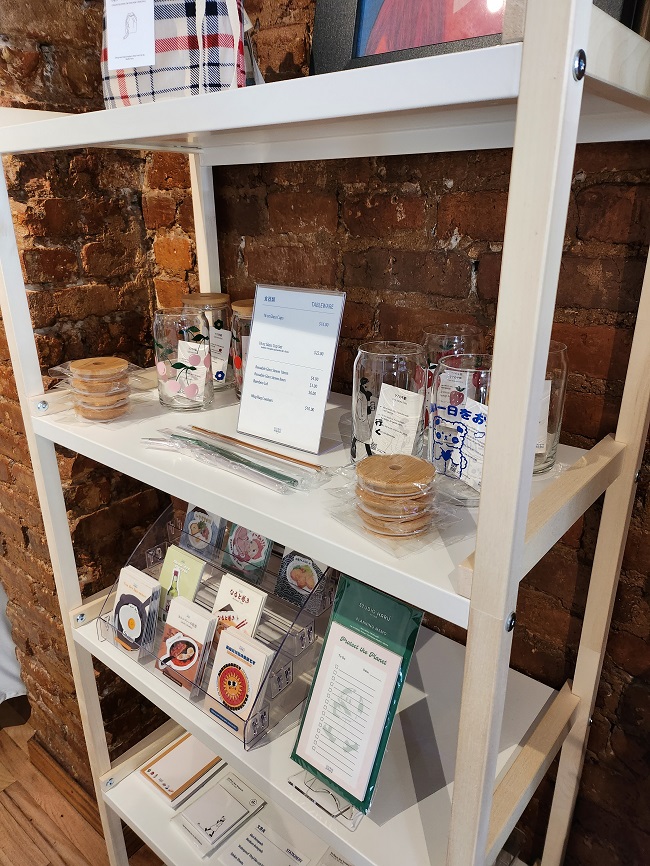
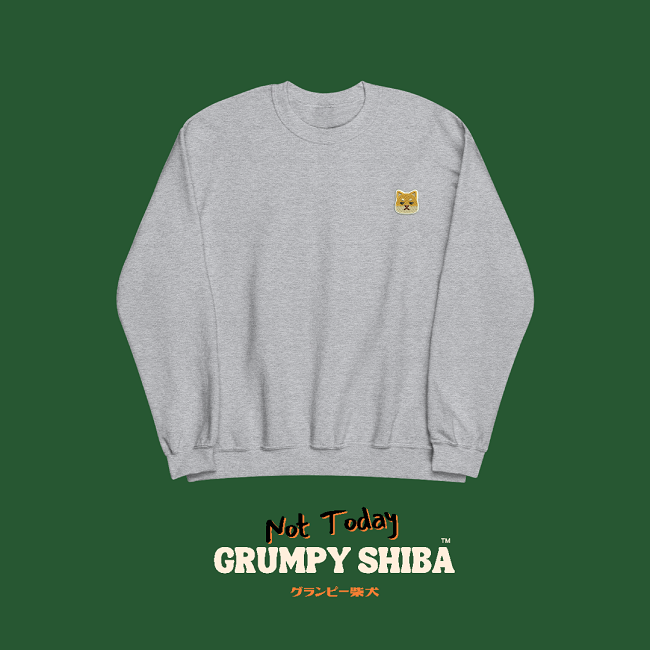
Please check out our online store to find her creative items for sale!
Also many other Japanese handmade artists sell their items on our platform.
View this profile on InstagramStudio Haru スタジオ春 ™ (@studioharu__) • Instagram photos and videos

We had an interview with TeaLoveCrochet , an artisan skilled in crafting Japanese Amigurumi and various functional items through the art of crochet.
With a keen crochet expertise, TeaLoveCrochet brings to life charming designs that draw inspiration from Asian cuisine, Harajuku fashion, and Lolita fashion.
Please check her instagram from here!

Riverside Wrapping Co. was founded by Emi, that beautifully merges traditional Mizuhiki art with contemporary designs. Emi expertly employs the intricate art of Mizuhiki to craft modern earrings that exude elegance and uniqueness.
Mizuhiki, a captivating Japanese art form, involves the meticulous creation of ornate cords using paper or silk threads. Originally employed for gift wrapping, ceremonies, and accessories, Mizuhiki cords have historically symbolized luck and prosperity. Over time, this art form has evolved, combining rich tradition with innovative expressions. The varied colors and shapes of Mizuhiki cords hold profound meanings, contributing to its significance as a cultural craft.
Explore Riverside Wrapping Co. ‘s innovative creations by visiting her website through this link.

“Pucci Ropa Jewelry” is a distinguished jewelry brand established by the Japanese artist Chihiro, presently situated in New York. Her collection encompasses an array of pieces including rings, earrings, and ear cuffs, crafted from sterling silver and brass. Notably, one of her signature designs is “ameba,” which symbolizes evolution and chance.
Please check her interview article from here!
